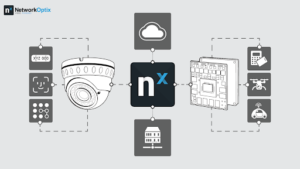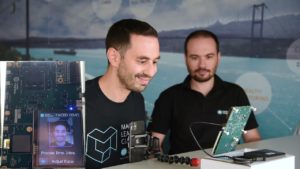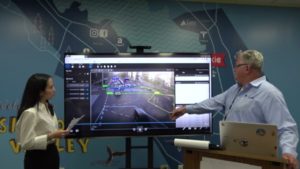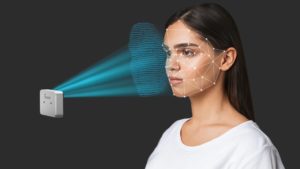Face Recognition Functions

May 2022 Embedded Vision Summit Slides
The Embedded Vision Summit was held on May 16-19, 2022 in Santa Clara, California, as an educational forum for product creators interested in incorporating visual intelligence into electronic systems and software. The presentations delivered at the Summit are listed below. All of the slides from these presentations are included in… May 2022 Embedded Vision Summit

Oculi’s Software-Defined Vision Sensor Enables Face Detection with Ultra-low Bandwidth
This video was originally published at Oculi’s YouTube channel. It is reprinted here with the permission of Oculi AR and VR technologies are hot new trends, with both driving the demand for face detection and face recognition technologies across many industries. Camera distortion, background noise, insufficient storage, and improper techniques are among the main challenges

Use Nx Meta to Build Enterprise, AI-Enabled Video Solutions at the Edge
This blog post was originally published at Network Optix’ website. It is reprinted here with the permission of Network Optix. In this article we’re going to take a look at Edge computing and how Nx Meta can help your organization rapidly develop full-stack AI-enabled video management applications. First: The Opportunity One of the largest emerging

AI Face Identification Using the Maxim Integrated (Analog Devices) MAX78000EVKIT
In this video, you’ll see how AI technology can be used to identify faces using the MAX78000EVKIT from Maxim Integrated (now part of Analog Devices), along with a camera and display. This face identification demonstration, shown by Erman Okman and Gorken Ulkar, members of the technical staff at Maxim Integrated, implements an energy-efficient convolutional neural

LAON PEOPLE Demonstration of Traffic Analysis Using a Deep Learning Solution
Luke Faubion, Traffic Solution Director at LAON PEOPLE, demonstrates the company’s latest edge AI and vision technologies and products at the 2021 Embedded Vision Summit. Specifically, Faubion demonstrates traffic analysis using the company’s deep learning solution. The traffic analysis program Faubion demonstrates doesn’t require installing a new IP camera. LAON PEOPLE’s AI solution provides vehicle,

Xailient Announces Face Recognition AI for Sony’s Intelligent Vision Sensor IMX500 with Impressive 97.8% Accuracy Up to 3 Meters
SYDNEY, Nov. 29, 2021 /PRNewswire/ — Xailient announced the world’s most power-efficient Face Recognition AI, which runs on the IMX500, the world’s first intelligent vision sensor with edge AI processing capability from Sony Semiconductor Solutions Corporation (“Sony”). Xailient’s Face Recognition enables high-speed edge AI processing with low-power consumption using Sony’s IMX500 – a chip so

BrainChip Demonstration of How the Akida Neural Processor Solves Problems At the Edge
Todd Vierra, Director of Customer Engagements at BrainChip, demonstrates the company’s latest edge AI and vision technologies and products at the 2021 Embedded Vision Summit. Specifically, Vierra demonstrates how the company’s Akida event-based neural processor (NPU) solves problems at the edge. Utilizing BrainChip’s Akida NPU, you can leverage advanced neuromorphic computing as the engine for

Synaptics Demonstration of Smart Video Conferencing on the Edge
Zafer Diab, Director of Product Marketing at Synaptics, demonstrates the company’s latest edge AI and vision technologies and products at the 2021 Embedded Vision Summit. Specifically, Diab demonstrates smart video conferencing on the edge in partnership with Pilot.ai. Enhancements in AI processing capabilities on edge devices are enabling a richer video conferencing experience. These capabilities

May 2021 Embedded Vision Summit Slides
The Embedded Vision Summit was held online on May 25-28, 2021, as an educational forum for product creators interested in incorporating visual intelligence into electronic systems and software. The presentations delivered at the Summit are listed below. All of the slides from these presentations are included in PDF form. To… May 2021 Embedded Vision Summit

“Case Study: Facial Detection and Recognition for Always-On Applications,” a Presentation from Synopsys
Jamie Campbell, Product Marketing Manager for Embedded Vision IP at Synopsys, presents the “Case Study: Facial Detection and Recognition for Always-On Applications” tutorial at the May 2021 Embedded Vision Summit. Although there are many applications for low-power facial recognition in edge devices, perhaps the most challenging to design are always-on, battery-powered systems that use facial

September 2020 Embedded Vision Summit Slides
The Embedded Vision Summit was held online on September 15-25, 2020, as an educational forum for product creators interested in incorporating visual intelligence into electronic systems and software. The presentations delivered at the Summit are listed below. All of the slides from these presentations are included in PDF form. To… September 2020 Embedded Vision Summit

“Multi-modal Re-identification: IOT + Computer Vision for Residential Community Tracking,” a Presentation from Seedland
Kit Thambiratnam, General Manager of the Seedland AI Center, presents the “Multi-modal Re-identification: IOT + Computer Vision for Residential Community Tracking” tutorial at the September 2020 Embedded Vision Summit. The recent COVID-19 outbreak necessitated monitoring in communities such as tracking of quarantined residents and tracking of close-contact interactions with sick individuals. High-density communities also have

“Challenges and Approaches for Cascaded DNNs: A Case Study of Face Detection for Face Verification,” a Presentation from Imagination Technologies
Ana Salazar, Senior Research Manager at Imagination Technologies, presents the “Challenges and Approaches for Cascaded DNNs: A Case Study of Face Detection for Face Verification” tutorial at the September 2020 Embedded Vision Summit. This talk explores the challenges of deploying serial computer vision tasks implemented with DNNs. Neural network accelerators have demonstrated significant gains in

Introducing Intel RealSense ID Facial Authentication
What’s New: Today, Intel introduced Intel® RealSense™ ID, an on-device solution that combines an active depth sensor with a specialized neural network designed to deliver secure, accurate and user-aware facial authentication. Intel RealSense ID works with smart locks, access control, point-of-sale, ATMs, kiosks and more. “Intel RealSense ID combines purpose-built hardware and software with a dedicated
“Designing Home Monitoring Cameras for Scale,” a Presentation from Ring
Ilya Brailovskiy, Principal Engineer, and Changsoo Jeong, Head of Algorithm, both of Ring, present the "Optimizing SSD Object Detection for Low-power Devices" tutorial at the May 2019 Embedded Vision Summit. In this talk, Brailovskiy and Jeong discuss how Ring designs smart home video cameras to make neighborhoods safer. In particular, they focus on three key

May 2019 Embedded Vision Summit Slides
The Embedded Vision Summit was held on May 20-23, 2019 in Santa Clara, California, as an educational forum for product creators interested in incorporating visual intelligence into electronic systems and software. The presentations delivered at the Summit are listed below. All of the slides from these presentations are included in… May 2019 Embedded Vision Summit
“Understanding and Implementing Face Landmark Detection and Tracking,” a Presentation from PathPartner Technology
Jayachandra Dakala, Technical Architect at PathPartner Technology, presents the “Understanding and Implementing Face Landmark Detection and Tracking” tutorial at the May 2018 Embedded Vision Summit. Face landmark detection is of profound interest in computer vision, because it enables tasks ranging from facial expression recognition to understanding human behavior. Face landmark detection and tracking can be
“Creating a Computationally Efficient Embedded CNN Face Recognizer,” a Presentation from PathPartner Technology
Praveen G.B., Technical Lead at PathPartner Technology, presents the “Creating a Computationally Efficient Embedded CNN Face Recognizer” tutorial at the May 2018 Embedded Vision Summit. Face recognition systems have made great progress thanks to availability of data, deep learning algorithms and better image sensors. Face recognition systems should be tolerant of variations in illumination, pose

